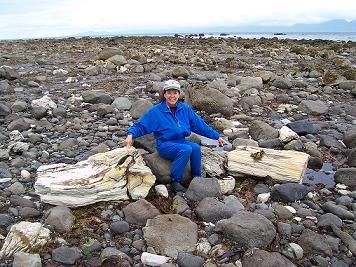
 |
 |
 |
 |
 |
| Home Page | Featured Articles | Awards | Photo Gallery | About Yvonne |
Can you name two states with petrified forests?
Arizona, our next-door neighbor state, is the obvious answer for one. But did you guess Alaska for the second?
A single bald eagle trains his eye on ten eager explorers splashing ashore onto the tiny island of Unga, site of Alaska’s 23 million-year old petrified “forest,” far out on the Alaskan Peninsula.
“The forest is best viewed at low tide,” advises our naturalist Aaron as we clamber out of Zodiacs, inflatable motorized rubber craft. We slog over wet black sand dotted with white clam, winkle and barnacle shells, orange crabs and purple mussels. Overhead, gray clouds mirror the gray-green Gulf of Alaska. A light sea breeze cools the air that even in mid-summer is still only 50 degrees warm.
We slosh through shallow tide pools toward cliffs covered with grass and nootka lupine, a flower related to the Texas bluebonnet. Ian, the group’s ornithologist, spots the bald eagle first. Binoculars, telescopes and cameras with zoom lenses pop out of parka pockets.
“Its nest is on that point,” says Ian softly, even though the bird is too far to hear us. The eagle’s sharp profile reveals the strong yellow beak, black body and distinctive white head of our national bird.
Although we hike directly under the eagle’s nest, the eagle does not move. But its “eagle eye” follows our every movement. Making no sudden gestures or loud sounds, we stride purposefully but quietly along the beach, now becoming rocky with gray granite chunks the size of basketballs. Our rubber knee-high Wellington boots slip on kelp fronds--reddish-brown leathery leaf-like structures, some as long as six feet--left by the retreating tide.
“Here’s the trunk of a small petrified sequoia,” says naturalist Aaron, stopping by what looks like a yellowish rock the size of a footstool. Unlike the black and gray speckled granite rocks surrounding it, this rock shows the definite striations of a slab of wood. One can even see whorls from which branches may have grown.

“This is the flank of the trunk,” continues Aaron. “It is still connected to roots that are also petrified and go into the sand. If we dug deep enough, we’d find them.”
“Can you tell the age of the tree by counting its rings?” asks Ruth, one of your explorer companions.
“Yes,” replies Aaron, “but I stopped counting after 500!”
Now knowing what to look for, everyone spots pieces of petrified trees, some as small and flat as a candy bar; others big as pillows. Stump remnants indicate many trees grew eight feet in diameter.
As cameras and video recorders record our finds, Aaron and Ian explain the process that brought a petrified forest to Alaska.
Over 23 million years ago, an immense temperate forest of Metasequoia, a close relative of today’s California redwoods and sequoias, Sequoia sempervirens and Sequoiadendron giganteum, spread down the west coast of North America from Alaska to California.
“A tremendous volcanic eruption on this island—you can still see the peaks—created volcanic mud mixed with glacial melt making a kind of slurry called ‘lahar.’ This lahar inundated the sequoia forest, breaking the trees and burying pieces and stumps. Everything became sealed under a cap of volcanic rock as high as or higher than that cliff,” continues Ian, gesturing to the eagle’s promontory.
“Why weren’t the trees vaporized?” asks Ted, another explorer.
“Because it wasn’t lava that covered them; it was this slurry-like lahar,” answers Aaron. “When it solidified, lahar preserved the organic material in the trees, kept it from rotting. Then when silica-rich fresh water seeped through it—and we’re talking millions of years here—it replaced every organic cell with silicates such as quartz, jasper and chert. That’s petrifaction, turning living matter to stone.”
Ian gestures to waves lapping the shore only a few yards away. “Over time, the sea eroded the volcanic cap leaving the stumps exposed. This is what we see now, but there’s more in the ocean and more beneath the volcanic flow above us.” He gestures to the eagle’s cliff again.
The group disperses to find and photograph more petrified stumps and pieces. Pete finds a piece of driftwood and a similarly sized piece of petrified wood and hefts them. “They look almost identical, but one’s heavy.” He holds out his left hand. “This one’s definitely rock.”
“Tide’s coming in and the wind’s picked up!” calls Rich, the vigilant Zodiac driver. “Time to head back!”
You’ve been so absorbed in the story of the petrified forest you haven’t noticed the weather’s worsened. Slatey-backed gulls mew and black-legged kittiwakes soar over whitecaps. An unseen golden-crowned sparrow calls mournfully. Even the eagle has disappeared.
As the Zodiac pulls away from Unga Island, you glance back at the slowly disappearing sand spit with its prehistoric remnants and wonder: where else under the world are petrified forests hiding?
Unlike the Petrified Forest National Monument in Arizona, Unga’s petrified forest does not lie on public land. Unga Island is owned by the Shumagin Native Corporation who grant permission to visit. Consult your travel agent for suggestions for expedition-sized cruise ships that include Unga Island in their Alaska itineraries.
c. The Ruidoso News Friday, August 17, 2007
